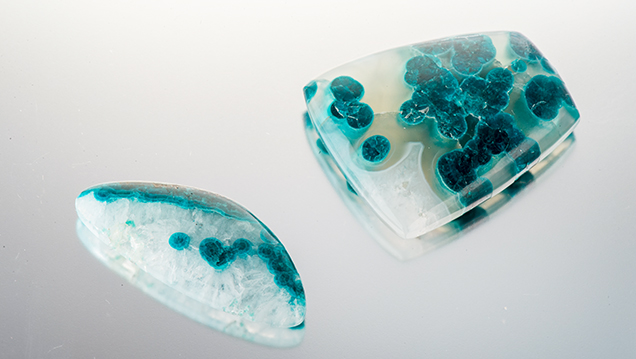Chrysocolla In Quartz

We obtained two cabochons of blue-spotted clear and near-colorless quartz, as seen above, that were reminiscent of “K2 stone” or “Raindrop azurite” seen in previous years (Spring 2012 GNI, pp. 55–56). Heher’s father bought the rough, which was crystallized around blue stalactites, at auction in the 1980s. It remained in storage until recently. The material was reportedly mined in Globe, Arizona, in the 1970s.
Gemological examination of the 19.16 and 52.96 ct cabochons revealed an RI of 1.54 to 1.55 in most areas, but approximately 1.5 in the blue area, and a 1.46 spot reading in transparent areas. Specific gravity ranged from 2.36 to 2.47. The fluorescence reaction to long-wave UV was weak white in fractures and the transparent areas. Raman analysis confirmed that the blue material was chrysocolla, the transparent to whitish areas were quartz, and the transparent cryptocrystalline areas were chalcedony. Raman analysis also indicated the presence of a hardened glassy polymer (polymethyl methacrylate). FTIR also confirmed the polymer, corroborating the stabilization that Heher indicated was needed to prevent crumbling or fracturing during the cutting and polishing process. The treatment conclusion on a GIA report would be “impregnated” or possibly “composite” if the polymer occupied significant volume or surface area.
Chrysocolla in quartz is not uncommon, but it is rare to see such defined stalactites resulting in a distinct orbicular pattern. This material often remains as mineral specimens rather than being cut for jewelry purposes.



